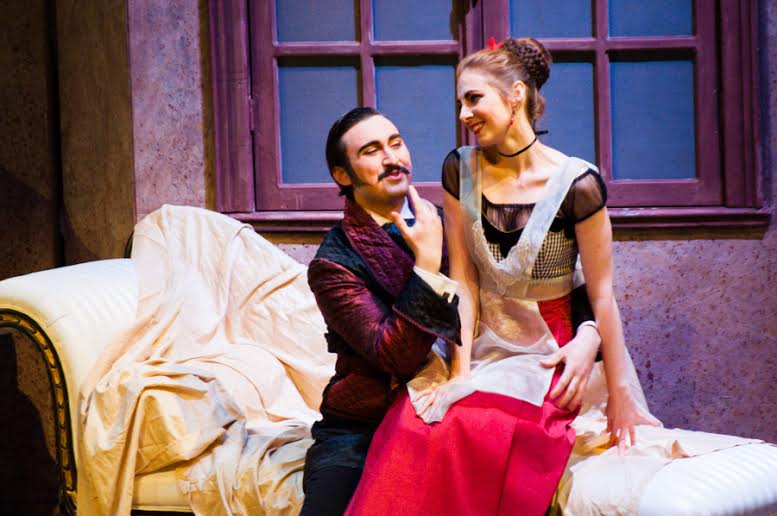To some, sitting through over four hours of warbling in Italian will always be torture. Others, though, might welcome an escape from everyday routines filled with stress and Buzzfeed breaks, to listen to a musical expression of what makes us human. From January 29 to February 1, Opera McGill performed Mozart’s The Marriage of Figaro with such musical expression in Pollack Hall, using two alternating casts during its four-day run.
On opening, thirty minutes before McGill opera students walked on stage to perform, conductor Gordon Gerrard spoke to audience members seated in a small lecture hall. A black-clad, soft-spoken Manitoban, Gerrard explained that Mozart was a master of the “ear worm” – a clumsy way of saying he composed unforgettable and timeless music.
The rest of his talk was phrased more gracefully. He reminded the audience of how incredible it is that a work put to music in 1786 can still resonate with us today, and how we recognize our own feelings in the romantic struggles of the characters. Above all, The Marriage of Figaro is a love story: Figaro and his fiancé Susanna are both servants to the same Count, who tries everything to stop their marriage because of his desire for Susanna. A kaleidoscopic and confusing web of romantic liaisons, subtext, and drama ensues.
For The Marriage of Figaro revolves around real love: its fun, absurdity, and agony. It is at its strongest when it expresses emotions that can’t be put into words; everything else is just filler.
A comic opera, The Marriage of Figaro, is meant to make you laugh as much as tug at your heartstrings. The cast, in addition to their vocal talent, played their parts with natural ease. There were times, however, when the emphasis on slapstick was overdone. In one of the most beautiful of the opera’s arias, a young servant-boy is forced by ladies of the court to sing a song he has written for the Countess. Voi Che Sapete, his song, is a pure but bittersweet rendition of the pain of adolescent longing. The emotions expressed chime with many, but it was a disappointment to see the actor (Stephanie Kallay) strut and beat her chest melodramatically, effectively playing the scene for laughs.
There are other eyebrow-raising moments of slapstick in Opera McGill’s performance, too, such as when Figaro and Susanna are reunited, and proceed to dramatically dry hump centre-stage. That moment did draw a genuine roar of laughter though, and for the most part the clownish humour serves well as a short relief from more serious content – better-known arias such as Canzonetta Sull’aria were so powerful you could feel audience members holding their breath.
Perhaps most remarkable though, was the deliberate way in which the production engaged its audience. In one scene, Figaro (Rolfe Dauz) sang at length about his hatred of women, in what was originally a rant against the ruling classes that Mozart was forced to change after a complaint from his patron. Figaro addressed men directly during the aria, and for this Opera McGill chose to light up the audience, with everyone literally in the spotlight as they were called upon to agree with the misogynistic sentiment. The audience also understood exactly what Figaro was singing: French and English translations flashed on a screen in time with the singers. While the deliberate sense of discomfort may have been intended to make the audience reflect more deeply on the opera’s themes, in many ways, the opera would have been better off if this part were removed entirely.
For The Marriage of Figaro revolves around real love: its fun, absurdity, and agony. It is at its strongest when it expresses emotions that can’t be put into words; everything else is just filler. Gerrard too explained before curtain-up that while acting moves the story along, characters only express their true emotions during the arias. Aria lyrics are simplistic, sometimes just one repeated sentence. However, the depth of feeling expressed is what keeps audiences returning to this opera for hundreds of years.
Overall, the story of The Marriage of Figaro inevitably plays second fiddle to its composition, which amounts to over four hours of music. Both of the Opera McGill casts rehearsed every day since the beginning of January. And at least for the singers in the final leg of recitals, the performance was truly remarkable, especially during the arias.
Through its powerful expression of timeless sentiments, Opera McGill succeeded in providing the audience with an escape into ourselves. While the emotional release ended with the show itself, Opera McGill also succeeded in making an “ear worm” of Mozart: the music plays on loop inside your head long after you leave the theatre.

